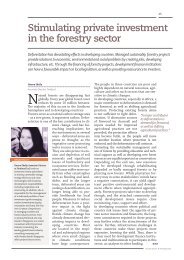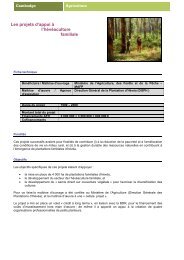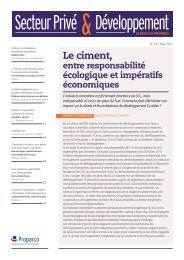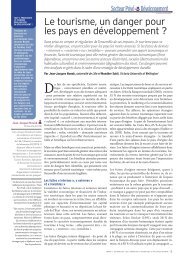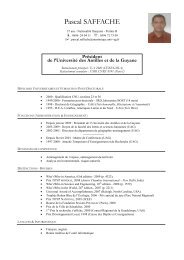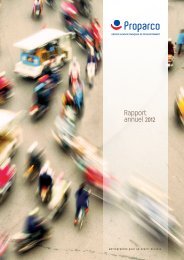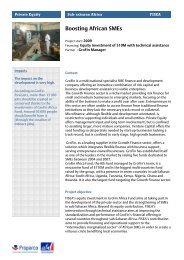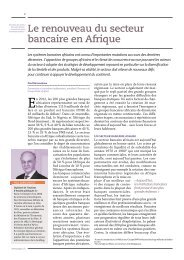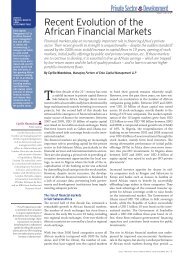Integrating Poor Populations in South African Cities - Agence ...
Integrating Poor Populations in South African Cities - Agence ...
Integrating Poor Populations in South African Cities - Agence ...
You also want an ePaper? Increase the reach of your titles
YUMPU automatically turns print PDFs into web optimized ePapers that Google loves.
1. An Urban History of <strong>South</strong> Africa: From 1652 to the Present<br />
Zones à Urbaniser en Priorité (ZUP, zones to urbanize <strong>in</strong> priority) and <strong>in</strong>dustrializ<strong>in</strong>g the<br />
production of social hous<strong>in</strong>g. In the mid-1960s, <strong>in</strong> response to this policy’s limits (only<br />
functional and centred primarily on social rental hous<strong>in</strong>g), the government once aga<strong>in</strong><br />
became heavily <strong>in</strong>volved. It implemented plann<strong>in</strong>g tools 22 and launched the development<br />
of new cities that were supposed to be a coherent wide-scale response to urban growth.<br />
Near the end of the 1970s, public assistance for s<strong>in</strong>gle-family houses was set up <strong>in</strong><br />
response to the demands from households. Add<strong>in</strong>g to this generalization of s<strong>in</strong>gle-family<br />
homes, the expansion of the road network and the massive appearance of hypermarkets<br />
gave birth to a characteristic urban landscape called bypass urbanism, <strong>in</strong> this case the<br />
result not of an urban policy but of a public hous<strong>in</strong>g policy. In 1982, a decentralization<br />
process began and aimed to give most responsibilities <strong>in</strong> the field of urbanism to<br />
municipalities. Simultaneously, and from the early 1980s, the city policy 23 was born.<br />
Indeed, the difficulties fac<strong>in</strong>g the ZUPs were progressively acknowledged and the<br />
government launched a re<strong>in</strong>tegration policy <strong>in</strong> these areas. It first gave rise to the “Grand<br />
Projets Urba<strong>in</strong>s” (GPUs, large urban projects), and then, start<strong>in</strong>g <strong>in</strong> 2004, to urban renovation<br />
projects accelerated and f<strong>in</strong>anced <strong>in</strong> part by the <strong>Agence</strong> Nationale pour la Rénovation<br />
Urba<strong>in</strong>e (ANRU, national urban renovation agency). On the legislative level, start<strong>in</strong>g <strong>in</strong> the<br />
2000s, certa<strong>in</strong> laws (and notably the Solidarité et Renouvellement Urba<strong>in</strong> law – SRU)<br />
fostered social diversity and consideration of the environment <strong>in</strong> town plann<strong>in</strong>g and urbanism<br />
actions.<br />
Similarities with <strong>South</strong> Africa<br />
47<br />
Despite very different political pasts (apartheid hav<strong>in</strong>g until recently determ<strong>in</strong>ed all of<br />
political life and passed down “<strong>in</strong>delible” urban landscapes) and differences <strong>in</strong> territorial scale,<br />
certa<strong>in</strong> similar stages <strong>in</strong> how urban development was tackled are to be emphasized. First,<br />
the politique des grand ensembles <strong>in</strong> France and the RDP house policy <strong>in</strong> <strong>South</strong> Africa were<br />
22. The 1967 Loi d’Orientation Foncière (land orientation law) <strong>in</strong>troduced the Schémas Directeurs<br />
d’Aménagement et d’Urbanisme (SDAU, development and urbanism bluepr<strong>in</strong>ts), precursors of the Schémas<br />
de Cohérence Territoriale (SCOT, territorial coherency bluepr<strong>in</strong>ts), and the Plans d’Occupation des Sols (POS,<br />
land occupation plans), precursors of the Plans Locaux d’Urbanisme (PLU, local urbanism plans).<br />
23. The Commission pour le Développement Social de Quartiers (neighbourhood social development<br />
commission) was created <strong>in</strong> 1981, and the Délégation Interm<strong>in</strong>istérielle à la Ville (<strong>in</strong>ter-m<strong>in</strong>isterial delegation for<br />
cities) was created <strong>in</strong> 1984.<br />
© AFD 2009 <strong>Integrat<strong>in</strong>g</strong> <strong>Poor</strong> <strong>Populations</strong> <strong>in</strong> <strong>South</strong> <strong>African</strong> <strong>Cities</strong>



